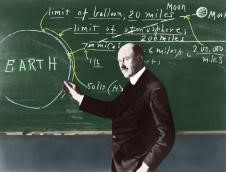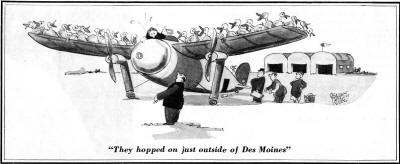 Table of Contents Table of Contents
The Boy Scouts of America has published Boys'
Life since January 1, 1911. I received it for a couple years in the late 1960s while in the
Scouts. I have begun buying copies on eBay to look for useful articles. As time permits, I will be glad
to scan articles for you. All copyrights (if any) are hereby acknowledged. Here are the
Boys' Life issues I have so far.
|
It was on March 16, 1926, that Robert
Goddard made history in Auburn, Massachusetts, by successfully launching the world's
first liquid fueled rocket. The propellant was a mixture of gasoline and liquid
oxygen. That was a mere ten year prior to this article that appeared in Boys'
Life magazine. Author T.E. Mussen comments that as of the writing, "thus far
the rocket has carried neither men nor recording instruments, nothing more than
the source of its own propelling power." Breathtaking speeds of 700 mph had
been attained and altitudes of 7,500 feet staggered the imagination with impossible
proposals - like someday sending human beings to the moon. The oft referenced
American Rocket
Society (ARS) was created in 1930, and was the leading professional group for
advancing rocket science. The group was planning for such missions three decades
before they became reality. ARS was merged with the Institute of Aerospace Sciences
in 1963 to become the present day American
Institute of Aeronautics and Astronautics (AIAA).
The Rocket Ship
By T. E. Mussen
 The fastest man-made vehicle ever built is the
rocket. It has already achieved the speed of 700 miles per hour - 1000 feet per
second - or nearly the velocity of sound in air. But thus far the rocket has carried
neither men nor recording instruments, nothing more than the source of its own propelling
power. However, the possibilities of the rocket are not entirely fictional, startling
as they may seem. The fastest man-made vehicle ever built is the
rocket. It has already achieved the speed of 700 miles per hour - 1000 feet per
second - or nearly the velocity of sound in air. But thus far the rocket has carried
neither men nor recording instruments, nothing more than the source of its own propelling
power. However, the possibilities of the rocket are not entirely fictional, startling
as they may seem.
The experimental models now in use are aluminum tubes, seven feet long and four
inches in diameter by the American Rocket Society, twelve feet long and nine inches
in diameter by Professor Goddard in New Mexico.
The driving mechanism or motor, which is really nothing more than a firing chamber,
is at the head of the tube. Behind it are three chambers containing gasoline, liquid
oxygen and nitrogen respectively. Tubes lead from the gasoline and oxygen into the
firing chamber. The nitrogen is used simply to create pressure, and also because
it is itself an inert, non-reactive gas.
The gasoline is pushed by the nitrogen in a small, steady stream into the firing
chamber. The oxygen is pushed by its own pressure. Mixed, fired, they expand like
gasoline and air in an automobile cylinder. But instead of pushing a piston as in
the gasoline engine, the expanding gases in the rocket rush out through nozzles
like exhaust pipes.
The recoil from this release propels the rocket - the phenomenon belonging to
the class described in Newton's law that every action has its equal and opposite
reaction. The revolving nozzles of a lawn-watering apparatus are an example of this
law, the nozzles revolving in a direction opposite to the ejection of the water.
The recoil of a gun just fired is another example. The rocket can be thought of
as a gun stock moving backward through space, firing as it moves. In the rocket
the gas molecules can be conceived of as the bullets pushing toward the earth while
the rocket is pushed away, with nothing to stop it except decreasing air resistance.
 The rocket operates twenty per cent more
efficiently in a vacuum. It needs no medium for traction. And its basic propelling
device requires no moving parts. Thus far it has been fired to altitudes of from
a few thousand to 7500 feet, but that has been done for recovery purposes, since
the results of each flight must be studied. And the Rocket Society has built its
rockets so that they float and has then fired them toward the sea, that they may
be more easily recovered. The rocket operates twenty per cent more
efficiently in a vacuum. It needs no medium for traction. And its basic propelling
device requires no moving parts. Thus far it has been fired to altitudes of from
a few thousand to 7500 feet, but that has been done for recovery purposes, since
the results of each flight must be studied. And the Rocket Society has built its
rockets so that they float and has then fired them toward the sea, that they may
be more easily recovered.
But the rocket's possibilities in covering great distances in a very short time
have been approximately calculated.
The theory, for instance, of a rocket flight from New York to Paris is that only
a brief part of the flight will be power driven, the rocket coasting after its initial
impulse. The rocket would be shot through the layer of dense atmosphere into the
high, rare altitudes. It would be aimed. It would still be travelling upward after
the initial charge was exhausted, later curving down toward its destination. The
path of its flight has been calculated like the trajectory of a shell.
The Rocket Society has estimated that the time of flight from New York to Paris
would be an hour and a half.
Light-sensitive cells would be used for accurate flight and landing. The rocket
would be aimed at a fixed star. The sensitive cells would be "tuned" to the light
from that particular star, much as a beam from Arcturus was used to open the Chicago
World's Fair. The cells could be connected to mechanisms in the rocket, switching
off nozzles on one side when the rocket veers, thus turning the rocket back to its
course.
By a time-clock device a new set of cells could be cut in when the rocket neared
the vicinity of Paris. These cells would be sensitive to a special light, such as
from a colored searchlight beam at the landing field. At a predetermined point they
would activate the release of a parachute, so that the rocket could float to earth.
The problems confronting a rocket flight to the moon, let us say, are far greater.
However, the flight has been contemplated and the American Rocket Society has in
its files the names of dozens of volunteers for such a flight.
In the first place, because, to effect such a flight, it would be necessary to
escape the field of the earth's gravitational attraction, a much greater initial
speed would be required. It has been calculated that that speed should be 25,000
miles per hour or seven miles per second. At that speed the rocket would be beyond
the force of the earth's attraction in about eight minutes. Thereafter, the original
aim and automatic navigation would guide it.
What seems most practicable is a step-rocket, that is, three or four rockets
hooked in series, firing consecutively. Three would be fired to reach the moon and
one to return. Getting back should be easier because of the lesser pull (because
lesser mass) of the moon, where an initial speed of only one mile per second would
be required.
Parachutes could not be used for landing on the moon, because there is no atmosphere
on the moon to support a parachute. It is thought, therefore, that reverse nozzles
would be used to check the speed - that is, nozzles exhausting the gas in the direction
of the rocket's motion.
But compounding rockets and mechanisms increases the load in a geometric ratio.
And with scientists, crew, food, instruments, oxygen aboard - 40,000 tons might
be the weight of such a rocket to the moon, such an "Astro-plane". That is as big
as the biggest battleship. And its cost would mount to thirty or forty million dollars.
So that a flight to the moon is at the moment very much an idle dream. But rockets
will be fired at the moon. And the first will no doubt be equipped with magnesium
flares that will go off automatically on landing. In that way we will know whether
we've hit the mark. And that will be a first step.
Posted August 3, 2022
(updated from original post
on 7/17/2014)
|